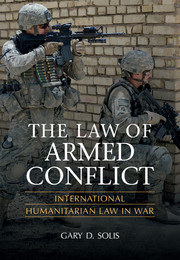Book contents
- Frontmatter
- Contents
- Table of Cases
- Table of Treaties
- Foreword
- Preface
- Acknowledgments
- LAW OF ARMED CONFLICT: INTERNATIONAL HUMANITARIAN LAW IN WAR
- LAW OF ARMED CONFLICT AND INTERNATIONAL HUMANITARIAN LAW: A FRAMEWORK
- LAW OF ARMED CONFLICT AND INTERNATIONAL HUMANITARIAN LAW: BATTLEFIELD ISSUES
- 9 Obedience to Orders, the First Defense
- 10 Command Responsibility and Respondeat Superior
- 11 Ruses and Perfidy
- 12 Torture
- 13 Rules of Engagement
- 14 Targeting
- 15 Attacks on Cultural Property
- 16 The 1980 Certain Conventional Weapons Convention
- 17 Gas, Biological, and Chemical Weapons Treaties
- References
- Index
- References
17 - Gas, Biological, and Chemical Weapons Treaties
from LAW OF ARMED CONFLICT AND INTERNATIONAL HUMANITARIAN LAW: BATTLEFIELD ISSUES
- Frontmatter
- Contents
- Table of Cases
- Table of Treaties
- Foreword
- Preface
- Acknowledgments
- LAW OF ARMED CONFLICT: INTERNATIONAL HUMANITARIAN LAW IN WAR
- LAW OF ARMED CONFLICT AND INTERNATIONAL HUMANITARIAN LAW: A FRAMEWORK
- LAW OF ARMED CONFLICT AND INTERNATIONAL HUMANITARIAN LAW: BATTLEFIELD ISSUES
- 9 Obedience to Orders, the First Defense
- 10 Command Responsibility and Respondeat Superior
- 11 Ruses and Perfidy
- 12 Torture
- 13 Rules of Engagement
- 14 Targeting
- 15 Attacks on Cultural Property
- 16 The 1980 Certain Conventional Weapons Convention
- 17 Gas, Biological, and Chemical Weapons Treaties
- References
- Index
- References
Summary
Introduction
At Strasbourg, in 1675, a Franco-German accord prohibited the use of poisoned bullets for the duration of the war between the two parties. Article 16 of Lieber's 1863 Code reads, “Military necessity…does not admit of the use of poison in any way…” In 1901, twenty-three of twenty-eight states attending the 1899 Hague Peace Conference ratified Declaration (IV, 2) Concerning Asphyxiating Gases. By 1907, four more states had either ratified or signed adhesions to the Declaration. (The United States was the sole nation to not sign.) “The contracting Powers,” the 1899 Declaration reads, “agree to abstain from the use of projectiles the sole object of which is the diffusion of asphyxiating or deleterious gases.” According to 1907 Hague Regulation IV, Article 23, “…[I]t is especially forbidden – (a) To employ poison or poisoned weapons.”
In late 1914, however, amid the futile slaughter of [World War I] trench warfare, the traditional legal and moral restraints on the use of poison gas began to erode under the pressure of military necessity…[T]he German High Command had interpreted the Hague gas-projectile declaration as banning only the release of lethal gases from shells specifically designed for that purpose….[Chemist Fritz Haber, winner of the 1918 Nobel Prize for chemistry] proposed instead that chlorine be released directly from pressurized gas cylinders, allowing the wind to carry the poisonous cloud over the enemy's trenches. This tactic offered a number of potential advantages: chlorine released directly from cylinders would blanket a far larger area than could be achieved with projectiles, and the gas would dissipate rapidly, allowing the affected areas to be occupied by friendly troops.
- Type
- Chapter
- Information
- The Law of Armed ConflictInternational Humanitarian Law in War, pp. 600 - 622Publisher: Cambridge University PressPrint publication year: 2010
References
- 1
- Cited by



